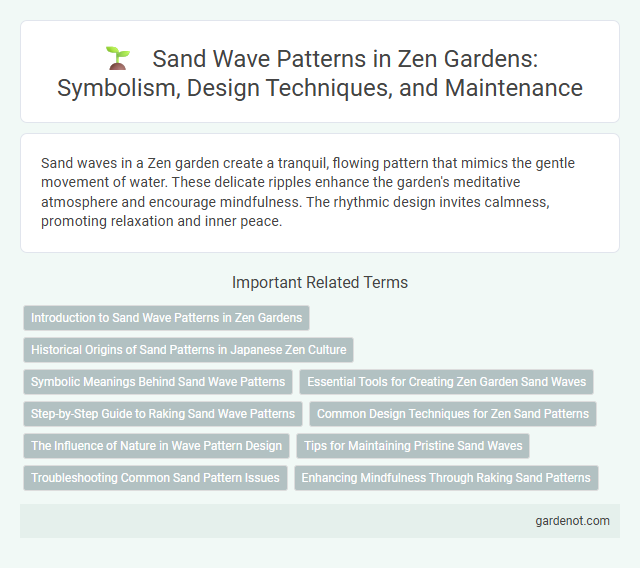Sand waves in a Zen garden create a tranquil, flowing pattern that mimics the gentle movement of water. These delicate ripples enhance the garden's meditative atmosphere and encourage mindfulness. The rhythmic design invites calmness, promoting relaxation and inner peace.
Introduction to Sand Wave Patterns in Zen Gardens
Sand wave patterns in Zen gardens symbolize water flowing gently around rocks, creating a tranquil visual rhythm that promotes mindfulness. These meticulously raked designs mimic ocean waves or river currents, enhancing the garden's meditative atmosphere. The repetitive, flowing lines encourage focus and calm, embodying the Zen principles of simplicity and harmony.
Historical Origins of Sand Patterns in Japanese Zen Culture
Sand wave patterns in Japanese Zen gardens originated during the Muromachi period (1336-1573), reflecting Zen Buddhist principles of meditation and tranquility. These meticulously raked patterns, symbolizing flowing water or ocean waves, embody impermanence and mindfulness central to Zen practice. The aesthetic simplicity and rhythmic designs enhance contemplative focus, deeply rooted in traditional Japanese cultural and spiritual heritage.
Symbolic Meanings Behind Sand Wave Patterns
Sand wave patterns in Zen gardens symbolize the flow of water and the natural rhythm of life, embodying peace and tranquility. These patterns represent the transient nature of existence, encouraging mindfulness and meditation. The deliberate arrangement of sand waves reflects harmony between human intention and the natural world.
Essential Tools for Creating Zen Garden Sand Waves
Essential tools for creating Zen garden sand waves include a traditional rake with evenly spaced teeth, a flat wooden board for smoothing, and a large brush to refine patterns. Precision in using these tools helps form harmonious, flowing sand waves that embody tranquility and balance. Quality natural sand enhances the visual effect and durability of the wave patterns.
Step-by-Step Guide to Raking Sand Wave Patterns
Creating sand wave patterns in a Zen garden involves using a specialized rake to draw smooth, flowing lines that mimic the natural movement of water. Begin by outlining the desired wave shape with gentle strokes, then gradually fill in the pattern with consistent, parallel rakes to enhance the texture and depth. Maintaining steady hand movements and uniform spacing between grooves ensures a harmonious and visually calming sand wave design.
Common Design Techniques for Zen Sand Patterns
Zen garden sand waves are created using carefully controlled raking techniques to form symmetrical, flowing patterns that represent water ripples. Common design methods include parallel lines, concentric circles, and curved waves, which promote tranquility and focus through their repetitive, meditative structure. Precision tools like wooden rakes with evenly spaced teeth help achieve uniform textures that enhance the garden's minimalist aesthetics.
The Influence of Nature in Wave Pattern Design
Sand wave patterns in Zen gardens are intricately inspired by natural elements such as ocean waves, wind-blown dunes, and flowing rivers. These designs reflect the rhythmic movement and energy found in nature, creating a calming and meditative atmosphere. The precise arrangement of sand waves enhances the garden's embodiment of natural harmony and balance, essential principles in Zen philosophy.
Tips for Maintaining Pristine Sand Waves
Maintaining pristine sand waves in a Zen garden requires regular raking with a fine-toothed rake to preserve the distinct patterns and prevent debris accumulation. Using a gentle, consistent motion helps avoid disrupting the smooth, flowing lines essential to the garden's aesthetic. Periodically removing footprints and smoothing uneven areas ensures the sand waves remain visually harmonious and meditative.
Troubleshooting Common Sand Pattern Issues
Sand waves in a Zen garden often lose their distinct shape due to inconsistent raking techniques or inappropriate sand texture. Address these issues by using fine, dry sand and maintaining steady, even strokes with a specialized rake designed for Zen patterns. Regularly smoothing the surface before creating new patterns helps ensure crisp, well-defined waves that embody serene flow.
Enhancing Mindfulness Through Raking Sand Patterns
Sand waves in a Zen garden are meticulously raked to create flowing patterns that symbolize water and movement, promoting a deep sense of mindfulness. The repetitive motion of shaping these sand waves encourages focused attention, calming the mind and reducing stress. Engaging with these intricate patterns enhances meditation practices by fostering presence and mental clarity.
Sand wave Infographic

 gardenot.com
gardenot.com